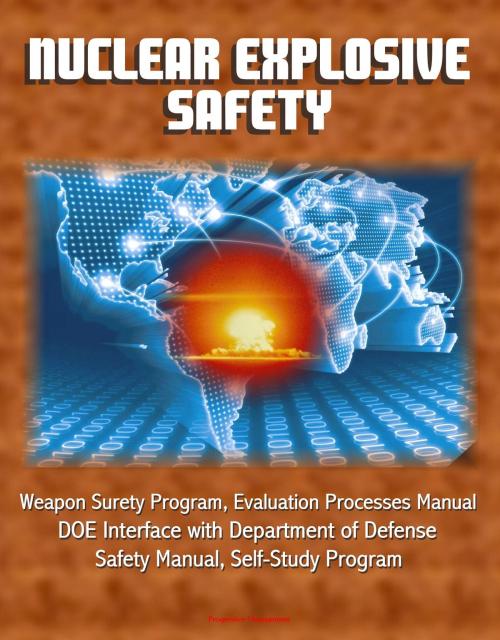Nuclear Explosive Safety: Weapon Surety Program, Evaluation Processes Manual, DOE Interface with Department of Defense, Safety Manual, Self-Study Program
Nonfiction, History, Military, Nuclear Warfare| Author: | Progressive Management | ISBN: | 9781301188208 |
| Publisher: | Progressive Management | Publication: | September 25, 2012 |
| Imprint: | Smashwords Edition | Language: | English |
| Author: | Progressive Management |
| ISBN: | 9781301188208 |
| Publisher: | Progressive Management |
| Publication: | September 25, 2012 |
| Imprint: | Smashwords Edition |
| Language: | English |
This compilation of six federal government unclassified documents provides unique insight into nuclear explosive safety issues.
Part 1: U.S. Department of Energy Continuing Training Self-Study Program - Nuclear Explosive and Weapon Surety Program
Part 2: U.S. Department of Energy Order DOE O 452.1D Nuclear Explosive and Weapon Surety Program
Part 3: Nuclear Explosive Safety Evaluation Processes Manual
Part 4: Nuclear Explosive Safety Manual
Part 5: U.S. Department of Energy Nuclear Weapon Surety Interface with the Department of Defense
Part 6: U.S. Department of Energy Nuclear Explosive Safety
NUCLEAR EXPLOSIVE AND WEAPON SURETY PROGRAM Objectives: To prevent accidents and inadvertent or unauthorized use of U.S. nuclear weapons and nuclear explosives. In conjunction with the Department of Defense (DoD), to protect the public health and safety by providing dual-agency judgment and responsibility for the safety, security, and use control (surety) of nuclear weapons. To establish nuclear explosive surety standards and nuclear weapon design surety requirements. To address surety vulnerabilities during all phases of the nuclear weapon life cycle and to upgrade surety during weapon stockpile refurbishments and/or new weapon development. To establish requirements and responsibilities for planned nuclear explosive operations (NEOs).
The two-person concept is implemented to ensure no lone individual has unrestricted access to a nuclear explosive. Site offices may also require two-person concept protection for other operations.
Each person on a two-person concept team must be certified in the Human Reliability Program; have authorized access to the nuclear explosive area (NEA); have technical knowledge of the task being performed; be knowledgeable of pertinent safety and security requirements; be in a position to detect incorrect or unauthorized acts and take appropriate action; the two-person concept may be implemented using either zone coverage or person-to-person coverage.
This compilation of six federal government unclassified documents provides unique insight into nuclear explosive safety issues.
Part 1: U.S. Department of Energy Continuing Training Self-Study Program - Nuclear Explosive and Weapon Surety Program
Part 2: U.S. Department of Energy Order DOE O 452.1D Nuclear Explosive and Weapon Surety Program
Part 3: Nuclear Explosive Safety Evaluation Processes Manual
Part 4: Nuclear Explosive Safety Manual
Part 5: U.S. Department of Energy Nuclear Weapon Surety Interface with the Department of Defense
Part 6: U.S. Department of Energy Nuclear Explosive Safety
NUCLEAR EXPLOSIVE AND WEAPON SURETY PROGRAM Objectives: To prevent accidents and inadvertent or unauthorized use of U.S. nuclear weapons and nuclear explosives. In conjunction with the Department of Defense (DoD), to protect the public health and safety by providing dual-agency judgment and responsibility for the safety, security, and use control (surety) of nuclear weapons. To establish nuclear explosive surety standards and nuclear weapon design surety requirements. To address surety vulnerabilities during all phases of the nuclear weapon life cycle and to upgrade surety during weapon stockpile refurbishments and/or new weapon development. To establish requirements and responsibilities for planned nuclear explosive operations (NEOs).
The two-person concept is implemented to ensure no lone individual has unrestricted access to a nuclear explosive. Site offices may also require two-person concept protection for other operations.
Each person on a two-person concept team must be certified in the Human Reliability Program; have authorized access to the nuclear explosive area (NEA); have technical knowledge of the task being performed; be knowledgeable of pertinent safety and security requirements; be in a position to detect incorrect or unauthorized acts and take appropriate action; the two-person concept may be implemented using either zone coverage or person-to-person coverage.















